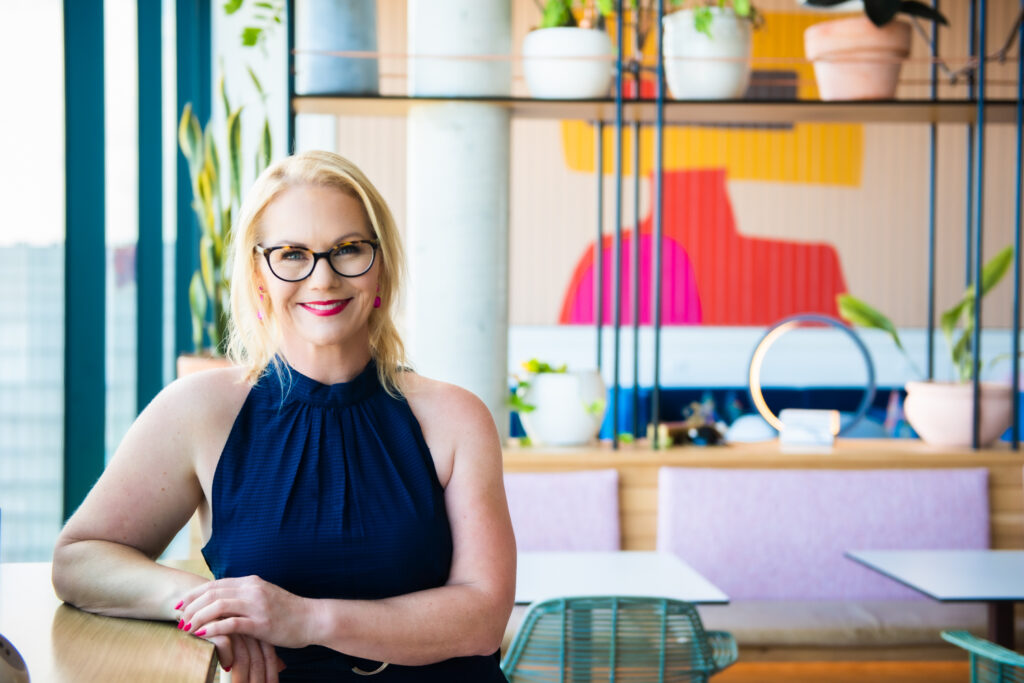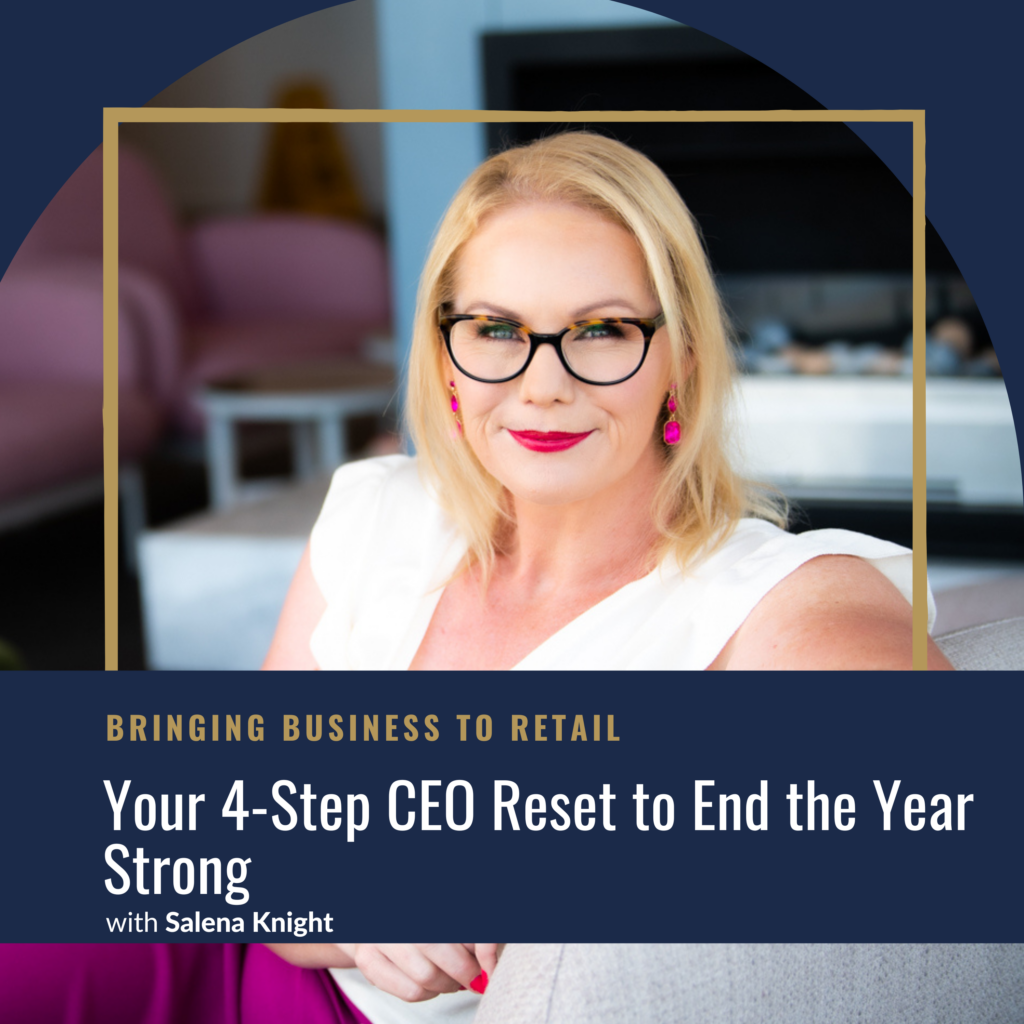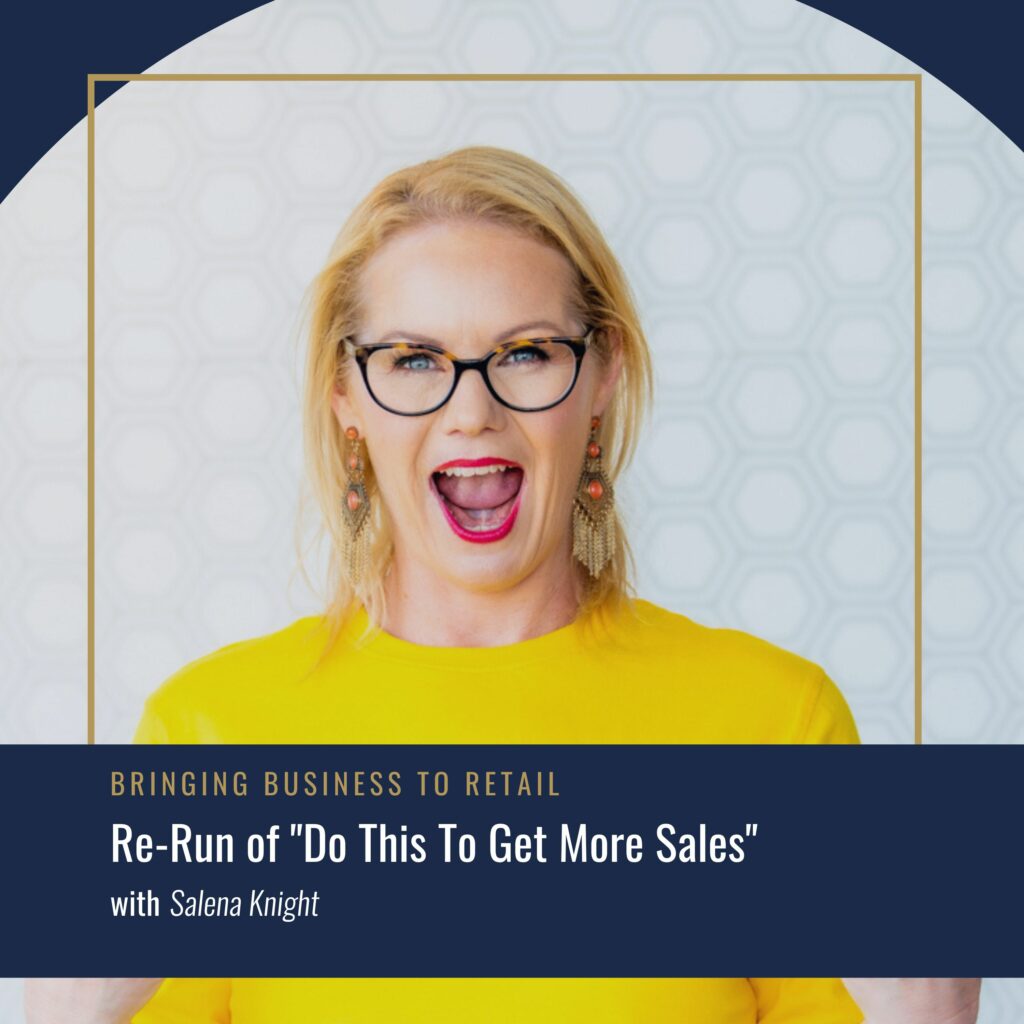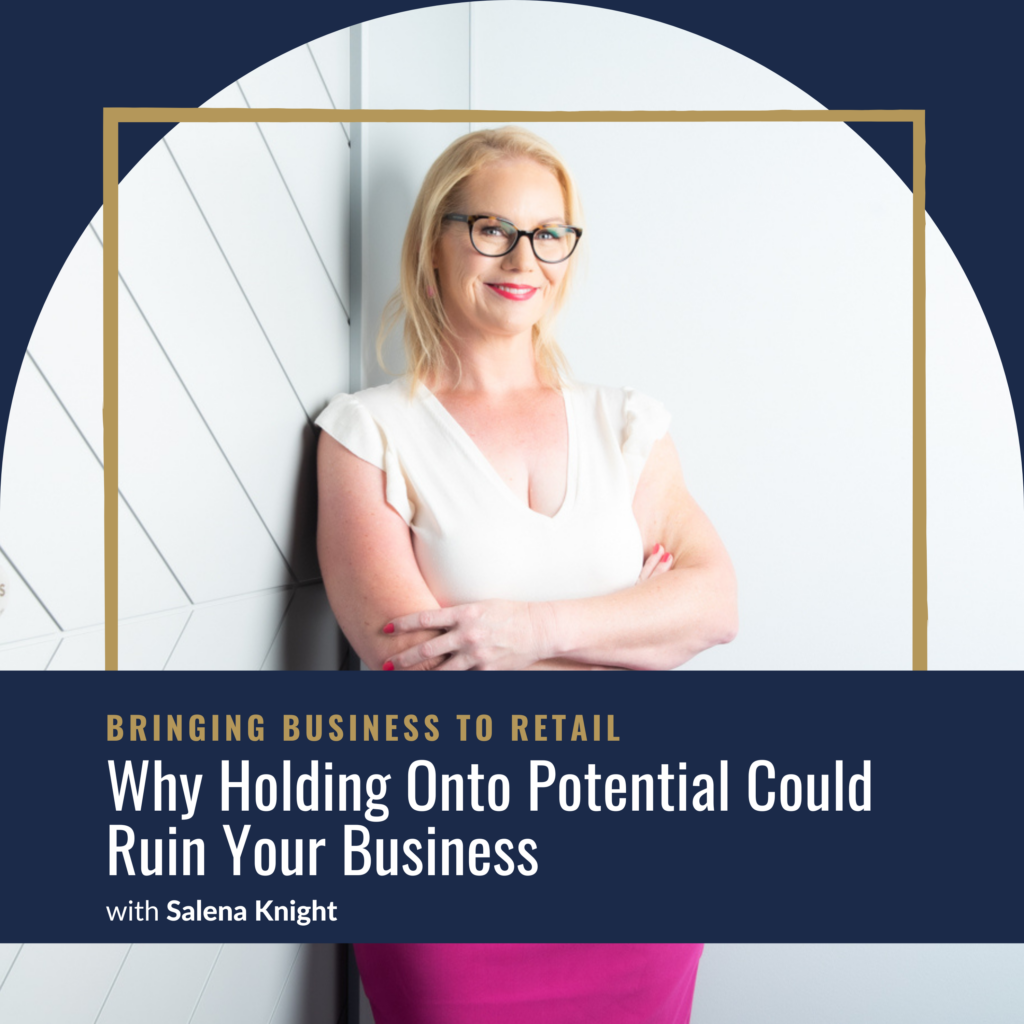
Shownotes:
What do rich people, trash wrappers, and $1,000 hotel rooms have to do with your pricing strategy?
Everything.
In this episode, Selena Knight breaks down a simple but powerful moment at a five-star hotel that changed how she thinks about sales forever. It’s not about being cheap. It’s about knowing your worth—and selling to people who value it.
What You’ll Learn:
- The real difference between price-sensitive and outcome-sensitive customers
- Why most businesses sit in the mid-market—and why that’s dangerous
- How wealthy people think, shop, and make buying decisions
- Real-life examples of premium positioning (art galleries, fabric stores, even dog treats!)
- 3 actions you can take this week to start attracting high-value customers
If you’ve been stuck trying to serve everyone, lowering prices to stay competitive, or wondering why sales are slowing down—this episode will give you the mindset (and strategy) shift you’ve been missing.
LISTEN NOW on The Bringing Business To Retail Podcast
[00:00:00] He had a piece of trash in his hand and there was a trash can, literally a meter away, maybe three feet away. But what did he do? When one of the staff came past, without any hesitation, he literally handed the trash. It was just a wrapper and said, could you put this in the bin for me please? That moment changed how I think about selling premium products and services.
Now, here's why. I was sitting at a hotel in Newport Beach not too long ago, and I couldn't help but hear a conversation between two couples. They were sitting right next to me. I was by the pool after an event, and I was using this time to map out my strategic plan. I was debriefing everything that had taken in and just prioritizing.
This was a five star hotel. It was like ridiculously fancy, and it's where the event was. And so I was staying at the hotel simply [00:01:00] because it was the, the place where the event was. And it was my second time in Newport Beach at a five star hotel. And let me just tell you, people think differently when they're rich.
So this couple that were next to me, older, clearly very, very wealthy, like dripping with, you know, Rolexes and, and very expensive jewelry. And there was something that happened. That couldn't, I just couldn't stop thinking about it and how different it was to the life that I lead. And so the, uh, one of the gentlemen, he had a piece of trash in his hand.
They were just sort of snacking away and he had a piece of trash in his hand and there was a trash can, literally a meter away, maybe three feet away, but he could have literally thrown the rubbish into the bin. But what did he do? When one of the staff came past without any hesitation, he literally handed the trash.
It was just a wrapper [00:02:00] and said, could you put this in the bin for me please? Now that moment changed how I think about selling premium products and services. Now, here's why. Hey there. I'm Selena Knight. I am a retail and e-commerce strategist, and welcome to the Bringing Business to Retail podcast where we talk about all the different things.
That you need to grow your business, your life, and of course your bank account. So today we're talking about something that could completely transform your business, how to sell to rich people, and why most retail and e-commerce businesses don't think about tapping into this market. This podcast was kind of inspired by the event that I saw.
At the hotel. And then something that I was listening to on the Alex Ozzy podcast, and he said something along the lines of, and forgive me if I get this wrong, solve rich people problems because they pay better. And if you solve rich people problems, they will make you one of them. And [00:03:00] when you solve rich people problems, you get to charge rich people prices.
So by the end of this episode, I want to maybe change the way that you think. About how you position your business, and if you are looking at targeting people who have more money, imparting some of the knowledge that I have discovered when you hang around with ridiculously wealthy people, because I think there is a fundamental difference to the way that wealthy people think.
And so that's what I wanna talk to you about, how wealthy people think differently and why targeting that middle of the market. Could be a very dangerous position for your business, especially right now. And then if I convince you that maybe premium is something a bit better, then it might expose you to different customers.
I wanna talk about how you could look at positioning your brand to attract those more premium customers. Alright? It will all make sense, I [00:04:00] promise you. Let's dive in. So if we go back to the trash can story, you might be thinking when I told you, well, so the guy was just being lazy. But I don't think that was what was happening at all.
He didn't even consider walking to the trash can or even throwing his trash in. He could have just left it on the table and walked away, but he didn't. And why? Well, I think it's because his mindset is fundamentally different. He wasn't thinking, well, how can I avoid paying for this? What he was thinking is, well, this needs to go in the trash.
How do I make my life easier? And for him handing over a couple of dollars because once the person he handed over the trash with a couple of dollars, I don't know how many dollars, 'cause American money is all the same color, but he handed the trash over with a couple of dollars to the staff member. So for him, handing over a few dollars to have someone else handle a really minor inconvenience is like, probably like you giving away a penny, like 1 cent.
It is [00:05:00] inconsequential, but when we think about the customer who's in the mid market, someone who only has. A hundred dollars in the bank. Parting with $2 means giving up 2% of everything they have. Or if they only have $10 in the bank, parting with $2 means giving up 20% of what they have. They're fundamentally very, very different things.
And so this is the first critical distinction that I have discovered is wealthy people value convenience. They value time and they value service above or else. So going to a five star hotel. And hey, if you wanna treat yourself and see how rich people think, it's a great way to do market research. I've talked about on this podcast before at, uh, another five star hotel.
I stayed at. When they did turn down service, they actually laid out all of things like bath salts and they rolled up my towel and they had, you know, several bath [00:06:00] towels hanging over the, the side of the bath. And I get that word out eventually the bath. And it's just a very, very different level. And all of these things are expected when you are dealing with people who are very, very wealthy.
And so they're not price sensitive. They're not paying 5, 6, 7, 800 a thousand dollars a night because they're penny pinches. They're doing it because they're outcome sensitive. So I. Session at that mastermind event where a financial strategist came in and talked to her, uh, talked to us about creating different revenue streams in our businesses.
So as entrepreneurs, quite often we have our money sitting in our businesses. So she was coming in and talking about having different revenue streams so that when you know, as the market changes, you can still live the life that you want to live. This, we were talking about, you know, having money potentially in stocks or in real estate or whatever way that you [00:07:00] wanted to do it, but also within your business, having different revenue streams that isn't just selling your customers.
All of this together made me, it kind of reinforced this point to me, which is if you think like a rich person and you solve their problems, then you can charge a premium for it because they will pay a premium for it. How does this relate to you? Well, let me ask you this. Is your business currently set up to solve problems for price conscious customers, or is it set up to solve problems for outcome focused customers?
Hmm, let me say that again. So is your business set up to solve problems for the price conscious customers that's the middle of the market or outcome focused clients? So the reality is that most business owners put their business into that mid-market level and there's like a better than even chance. If you are listening [00:08:00] to this, then you are in that mid-market niche.
You might be in just affordable, or you might be in that slightly more expensive, but still affordable. And most businesses, especially in retail and e-commerce, they position themselves here. They want to be, um, I'm gonna use the word affordable. Because most people can afford what you want. You, you're dealing with the general public.
Most business owners sit there themselves and they want to be accessible to as many people as possible, but most importantly, they wanna serve people who are like them because most of the people that we work with built their business because they couldn't find a product or they found a, a gap in the market that solved their problem.
And so they wanted to take that problem and those products out to their customers. So you end up serving people who are very like you. But here's the problem. When the belts tighten and they will always tighten, that is the economic life cycle. There's always gonna be the time when you know [00:09:00] there's, there's fat on the bone and is that the saying?
There's fat on the bone. There's always gonna to be the times when there's money to spend, and then there's gonna be the times when things get difficult and people tighten their belts. And the first people to cut back on discretionary spending are always those middle market buyers, huh? Can you see a problem here?
If you are catering to the masses and the masses have to pull back their spending, then by default what's gonna happen? Your revenue is going to go down. Now, this may be a bit controversial, but affordability. Could just be a race to the bottom because there's this constant battle to offer the best price, and you don't wanna get into this hamster wheel of lowering your prices because your competitors are lowering their prices and you're selling the same things as everybody else.
And that is a game that the only person who wins in the long term is gonna be a chain store because they can go back to suppliers and [00:10:00] they can negotiate better terms. And those terms still mean that they have the margin. But you don't. So if you are attracting customers who are looking for a cheaper option or the cheapest option, those customers aren't gonna be loyal to you.
They're gone the minute that they find a better deal somewhere else. And so in times of economic downturn when customers are feeling the pinch. The first thing that they're going to cut out is that discretionary spending, or they may not cut it out, they may just pull back. And that's what we're seeing a lot of right now, is the average order of value.
The average basket size is reducing 'cause that mid-market is choosing, what are they going to spend their money on? And instead of just spending, because they, you know, they want it, they're spending more along the lines of, huh, well I want it, but which one do I want the most? And so if you are in that mid-market and you are selling things that other people sell, then just remember that there's no strong [00:11:00] emotional value tied to you.
When things get tight, we're just looking for the best offer. But when it comes down to it, most people don't want cheap. They want to feel secure and successful, and they wanna feel good about themselves. And so then you end up in this little bit of a conundrum, which is if you are the cheapest for a product that other people are selling, people might start to think that maybe you're not legit.
Maybe it's a scam website. And so there's this very difficult and very fine line between being the same as everybody else, but also being the one that people come to. Alright, so who are the people who don't cut back when things get a little bit tighter? Well, it's the wealthy people. It's the high value customers.
I was at a five star hotel and the place was booked out and it had hundreds of rooms, and it was not a conference that was on. There were only a handful of people at the event I was at. So they have the money. Now let me share [00:12:00] the perfect example for what is happening in the economy right now and how wealthy people have not stopped spending.
So a friend of mine owns an art gallery That sounds so bougie, doesn't it? A friend of mine owns an art gallery. A friend of mine is an artist and she opened. After many, many years, an art gallery. Now one of the services that they offer, because she's so ridiculously smart when it comes to marketing, but one of the services that they offer is having the artist to personally come to your home and install a painting that you buy.
Now the artist doesn't do the work. The artist is not sitting there with a hammer and nail at, you know, a multimillion dollar property hanging up the artwork. No, they have carpenter, a builder, I don't know. They have a professional who, artist installer, who comes to do the work. The artist just stands there and directs and comments on their beautiful lighting and the placement.
And this would be the perfect spot because look at the light coming in, it compliments the color because that's what arty people do. [00:13:00] Now, depending on the price of the painting, this service costs anywhere between $500 and $5,000. But here's the thing, the wealthy clients will happily pay because afterwards they get to tell all of their friends, oh, look at my gorgeous painting.
I had the artist here installing that for me. And oh, they, they talked about how it compliments the, the sofas so well, or how the, look at how the light comes in and it just hits those sparkling, what they really buying. When they hire the artist to come in, isn't the artist to come in and give them platitudes about how well it looks in the space?
What they're really buying is the status and the prestige to say to their friends that they had the artist come and install the piece in their home. So do you see how this is very, very different from trying to offer the lowest price of artwork? I mean, you can go online and there's so much artwork out there, but what they're offering is something different.
How do you position your [00:14:00] business to appeal to those higher value customers or even wealthy customers? So we have a number of five X clients, believe it or not, who have fabric stores. And those fabric stores generally have focused in the beginning on having everything from. The cheap, basic, solid color prints right through to premium imported fabrics.
And for years they've thought that having variety was their strength. And I, I, I'm lumping everybody together here because it's not just fabric stores. We've actually had this with a number of businesses and in fact, I'm gonna go out on a limb and say, this is probably the vast majority of you. We could just take this example and insert it into your business as well.
So. They had all the things thinking that when their customers come in, they had to have the thread, the zippers, the basics, and the fancy pants fabric. But when they've done some market research with their current customers consistently, the message [00:15:00] is, well, we come here for the good stuff. We come here for the premium fabrics.
We come here to buy the stuff we can't buy anywhere else. So despite having a wide range of products, they discovered that they can't compete with big stores like Joanne's because they have so much buying power. They have so many stores and all those basic fabrics, they can always sell them cheaper.
Those chains buy by the container load and their prices reflect that. But their customers were coming for the premium stuff, the stuff that they couldn't buy everywhere. Now, think about it. Had they have just adapted into this and niched down years ago and focused on those top spending customers, there's a good chance that their revenue would've been significantly higher for a lot of years.
And when we put that into compounding millions of dollars. They would've attracted more of the high value customers because what do high BA value customers do? They talk [00:16:00] to their friends about this amazing place where they bought the thing they bought to talk to their friends about this amazing gallery where the artists came and installed it.
Like people hang around with like people. So if you can find your whales, then they're gonna bring more whales in. So how do you shift this in your business? Well, I. First and foremost, most, I'm always about the data, and this is one of the biggest missed opportunities in retail and e-commerce, is if you wanna start selling to the high value customers, you have to understand them.
And I'm not talking about just guessing what they want. I'm talking about finding out, finding out who is already buying your most premium products, what are the problems that they're trying to solve, either with those products or coming to you. So think about it for the fabric stores. The problem is, I can't buy this everywhere, so I'm gonna come to your store because you have a curated range of these beautiful premium fabrics.
I can go to Joanne's and I can buy all of the [00:17:00] things, but I can't buy this beautiful imported fabric. And so think about also how do they make their buying decisions? Are they making their buying decisions? Remember right back at the beginning I said they value convenience. So do you offer express shipping?
Do you offer same day delivery? I'm not saying that this is right for all businesses, but you have to think about what is the thing that works for them, not for you. I mean, while I've been away, I door dashed some melatonin because my whole time zone thing was not working. Like I was not gonna get in a car.
I didn't have a car, but I was not gonna get in a, an Uber and go to the convenience store. I'd just rather pay $7 or whatever it was to have it delivered to me because at the same time, I can continue to do the things that I needed to do so I could continue to attend the event and still get my melatonin delivered.
So think about that. Think about, I mean, Uber and DoorDash and all those places are great ways of [00:18:00] seeing how someone went to the market and found a problem and looked at what is the most, you know, what are the problems that they're solving, and how are you gonna make your buying decisions? So how do you make this shift in your business?
First of all, dig into the customer data. This one is probably one of the biggest missed opportunities in retail and e-commerce. If you want to start selling to high value customers, you have to understand them, and I'm not talking about guessing what they want. I'm talking about finding out who is already buying those premium products that you sell.
What kind of problems are they trying to solve when they buy those products from you, and how do they make their buying decisions? So it could be that you offer express shipping or same day delivery, but your competitors don't. So think about why are they buying and how, what is that deciding factor that makes them think, this is where I'm buying my product from, or this is the reason I'm gonna use this company to do [00:19:00] this thing.
The more you understand their needs, the more you can craft your offerings around them. Now, here's the thing, they don't think like you do, and I would say that one of the things that you can think about is as you have gotten older and probably wealthier, the way that what you're prepared to spend money on has changed.
Like I was saying, nowadays we're happy to Uber or we're happy to get things door dashed and delivered to us, whereas once upon a time, I would never have spent the money for that. But now I'm weighing up the time and the convenience and what can I do in the time that I would normally spend going to the store.
For example, I mean, I door dashed a battery, a set of batteries the other day because I needed them for my camera, and I had a choice. It was go to the store, which isn't very far away, but by the time I got in the car and went down there, it was. Pouring down with rain, so it meant that my hair and my makeup was probably gonna get ruined.
I went down there, bought it and came back. I was probably gonna lose 45 [00:20:00] minutes. Let's be honest. I could continue to work and have that item brought to me for, I think it was $6. I can make more money in 45 minutes than $6. If you don't know how these people think, you have to start like listening to podcasts.
You have to start getting around those people to hear the conversations that they're having. I mean, a foot calling this podcast $12,000 body scans and boob jobs, because that was the actual conversation that was going on next to me while I was at the hotel. They were talking about how all their friends were doing $12,000 body scans and were on subscriptions to do this two or three times a year.
And they were talking about which company, like, oh, are you with X company or are you with X Service? I'm like, I don't get a 12 mate. Do I need to get a 12,000 body scan? I don't know. And so just listening to the conversations that these people have will [00:21:00] help you to have a frame of reference. So let me give you some really simple ideas of how you could maybe implement this into your business.
If you sell furniture, just like the art gallery, if you sell, say furniture, consider offering a design and installation service. 'cause what wealthy clients want is the Instagram worthy living room that all of their friends comment on. They don't want to spend every Saturday for the next month, t trawling through furniture stores.
Now you might enjoy doing it. They probably don't. And in fact, the things that they want may not be available in the general furniture stores. As you start to move up the food chain when it comes to design services, there are entire niches where you can't find these products available to the general public.
They're only available to designers and architects. So even, you know, moving to that next level is, oh, shock horror. Could you make your product not available to everyone? Hmm. I don't know. Have a think about it. [00:22:00] But remembering that this is not what they wanna spend their Saturdays doing. They don't wanna be sitting there t trawling through the local furniture stores.
They just want somebody to present the best item for them that's going to look good and make them look good. Because remember, when you focus on those higher spending customers, you're not just offering them a product. You are offering them an experience that meets their emotional needs. These customers buy based on what you can do for them, not just what you sell to them.
So I know that the vast majority of you listening offer a hundred, if not a thousand times better service than a chain store. You might gif wrap, take orders over the phone, arrange for a team to walk a customer through setting up a machine that they've just purchased. But here's my question to you. Are you charging for that value or do you just give it away?
You need to be charging for the value that you provide, not just the product [00:23:00] costs to make or sell the item. And I'm not saying that you necessarily have to even charge an extra fee, but you can build that into your product cost because when you can separate, when you can differentiate yourself from your competitors, sure, you can buy this sofa, but will we come out and make sure it's the best sofa for you?
I don't know if you've bought a sofa lately. I bought a sofa last year, and I can guarantee you that nobody in the furniture stores offered to come to my house to make sure it was the best sofa I. Clearly I don't hang around with those kind of people to get me into those kinds of places. I did the schlep of all the stores on Saturdays until I could find the one I wanted.
So something as simple as that. Offering to have someone come to your home to measure up, to make sure that the sofa that they're going to get is going to fit. I mean, they make you tick a box. I've measured my front door to make sure I can get this sofa in there. You can start charging [00:24:00] for the value that you provide, not just what it costs you to sell your products or what it pro costs to make and sell your products.
So the most successful businesses don't sell based on what it costs. They base their pricing on how it transforms the customer. This is Marketing 1 0 1, sell the transformation. And if you don't believe that your product is worth a premium price, then how are you going to expect your customers to? If we come back to the idea of you trying to get in at the lowest level, then what you are doing for high value customers is you're actually making your brand worth less or worthless.
Okay. Strategic pricing is all about how you communicate that value. Maybe you have the biggest range of pink party hats, but you might sell all those party hats might be. Party hats that you can buy at a whole bunch of different stores. But the fact that you [00:25:00] sell the largest range means there's a really good chance that someone will just come there and buy the thing that they want because you offer it in one space.
You offer the ability to go and see, oh, that one, that one, that one or that one, and then I can just make my mind and put it in my cart. I don't have to spend hours looking for the perfect thing. So when you position your brand as high value, you have to back it up with pricing. And I've, I tell this story quite often, so forgive me if you've heard this one before, but we used to sell in our stores this beautiful wooden stacking toy, like the little pyramid stackers.
You know, you put the, the blocks on top of the blocks and it's big ring at the bottom, and a small ring at the top. And they were beautiful, and we used to sell a lot of them, but we would sell them for $20 because we bought them for 10. This was a little while ago, but we bought them for that price because the people who manufactured them, their ethos was being able to deliver high quality wooden toys that everyone could afford.
But what we found [00:26:00] was after listening to what our customers were saying, people would pick it up. They would say it was beautiful, and then they would put it back down because they thought it was too cheap. So what did we do? We tested, we put the price up from 1995 to 29 95. So we went from 20 to 30. We sold more.
We went from 30 to 40. This is the same product that you could buy from another retailer five minutes away, but we were charging $40 for the same product. They were charging 20 because there was an expectation in our store to be more premium. And what happens? We sold more of them. And here is the beautiful thing about targeting wealthy people.
People who pay more, one, generally pay on time. Two, generally pay upfront. They're not haggling over Afterpay or putting things on lay by or layaway. People who pay more probably won't be DMing you at 10:00 PM asking where their [00:27:00] order is. Or if they do, they'll expect to pay for the privilege of getting a response outside of business hours when you charge a higher price.
You actually have more money to be able to continue building in the value of your business to your customers. You can build in a better customer experience than your competitors because you have more dollars in the bank to be able to do so. Huh? Now you start differentiating yourself even more. 'cause you have more money to deliver a better service or to deliver a better product.
Think about it. You won't be helping anyone if you end up out of business because you don't have the cash or the customers to stay open. So. What's the big takeaway from today's episode? If you wanna grow your business and stop fighting in that affordable mid-market pricing battle, the one that actually constricts when things get tight, when economic cycle, as it is brought to do, go up and down.
When that [00:28:00] goes down and everybody pulls in their belts. If you wanna move away from that, you need to make a shift. So shift from selling based on price to selling, based on value shift from offering affordable options to premium experiences. So if we come back to the fabric store, huh? Now that we're getting rid of basics and, uh, notions and the, and things that you can buy at the local Joann's.
You have the money to offer a more extensive range of the things your customers want, and maybe you offer to package things together. Maybe you offer same day delivery. It's about listening to what your customers want. When you stop having money tied up in stuff people don't want. You can start to put it into the things that they do want, which means you are gonna turn over more product, which means you're gonna be able to continue to freshen up your product mix, which means your customers are gonna come back over and over [00:29:00] again.
And sure, you might alienate the bargain seekers, but the bargain seekers are the ones who couldn't afford your product anyway. So shift from being an affordable option to a premium experience shift from competing for the cheap customers to actually attracting the higher value ones who understand the worth of what it is that you offer.
Maybe it is the best range. Maybe it is the smallest range, Shakara, maybe it is the most curated range. So here are three actions that you can take this week. To be able to start to position yourself as being not mid-market and not affordable. The first thing is go and identify your top 20% of customers and look at what they have in common.
What are they willing to pay more for? You may have to pick up the phone. You may have to do a little bit of cyber stalking on LinkedIn. You may have to follow them on social media and see the comments that they're making. But this kind of research, just taking your top [00:30:00] 20% of customers, Hey, just taking your top 20 customers and spending the time to do the research will be able to help you differentiate.
Then look at creating one premium offering that solves a specific problem for those people. Now, I'm not saying you should go and get rid of everything today. What I'm saying is you start to build a plan to cater to those highest value customers. So maybe you sell pet food and at the moment you sell all the pet foods, but actually what you've realized is the best customers buy raw food.
So now if you stop having all of the things and you just focus on the raw food and maybe the high value treats that these customers are prepared to pay for, if you are paying to feed your dog raw food, then you have the budget to be able to feed them more high quality treats. And I'm gonna be honest, I've been to a high quality dog treat website.
I have to say that really, really slowly. [00:31:00] Otherwise, the words are all gonna get mentioned, mushed up together. I am shocked. That people will pay $150 for a small bag of organic grass fed jerky for their dogs. I'm like, that is not me. I'm not there yet. But clearly there's a market for people who do. And you think about that selling one bag of $150 treats.
First of all, I'm gonna almost guarantee that there's a better margin in that. But two, how many of the other regular bags would you have to sell to hit that same price of one packet of treats? Huh? Thinking about it start to create or think about the premium offering, the experience you wanna bring to your customers, that solves a specific problem for these high value clients or customers.
So if we go back to these dog treats, that website didn't have. 500 SKUs. It didn't even have a hundred kus. I'm gonna say they maybe had about 30 things to pick from. [00:32:00] All they sold was very expensive treats for dogs. That's it. 30 SKUs. As a customer, how much easier does that make my life? If this is what I'm looking for, I don't have to go through pages upon pages of your website.
I got 30 things to choose from. I can sort by chicken, I can sort by beef, I can sort by venison, I can get a sampler pack. So once you do that, then woo, are you waiting for this? Like, I hope you're sitting down. I'm gonna tell you to raise your prices on at least one thing where you are currently delivering more value than you're charging for.
What is that thing? It could be different for your business. It's like the artist with the art gallery. It's like the home furnishing store where the designer will come out thinking about if you build that into your pricing. Like just raise the price. Raise the price on one thing that your customers will pay money for, and I'm almost gonna bet you will not lose sales.
Remember, rich [00:33:00] people will pay more if they believe that there is something in it for them. So stop worrying about being affordable. Start thinking about how you can provide value that people are willing to pay for. Maybe that is not you, but you selling to you. Maybe it's not the best part of your business.
It's not gonna get you to the next level. It's not gonna get you to having the ability to create different income streams by finding these different niches. You are not your best customer. So start thinking about how you can provide value to the people who are willing to pay for it, because ultimately it is not about.
The price of the trash can. It is about the value of never having to think about the trash can in the first place. Hey there, I hope that you have found this episode useful. I mean, you might not be ready to go out and charge a premium amount for the high value client, but maybe just maybe, maybe you have stopped to think about the fact [00:34:00] that you overdeliver.
Just maybe you can charge for what you believe is a baseline, but other people would be willing to pay you for. Righty. If you found this value episode valuable, please make sure to subscribe and leave a review and let me know on Instagram, I'm at Lisa Leader Night, which of these actions you are going to implement?
Or if you had a bit of an insight, a bit of a light bulb moment, make sure to tell me what that is because I love hearing from you guys. Alrighty. Thanks so much. I'll see you on the next episode. So that's a wrap. I'd love to hear what insight you've gotten from this episode and how you're going to put it into action.
If you're a social kind of person, follow me at the Selena I. And make sure to leave a comment and let me know, and if this episode made you think a little bit differently or gave you some inspiration or perhaps gave you the kick that you needed to take action, then please take a [00:35:00] couple of minutes to leave me a review on your platform of choice.
Because the more reviews the show gets, the more independent retail and e-commerce stores just like yours, that we can help to scale. And when that happens, it's a win for you, a win for your community, and a win for your customers. I'll see you on the next episode.
Share this episode
Watch The Video

Ready For More?
Facebook-f Instagram Linkedin LISTEN NOW As the holidays hit full swing and the retail rush










